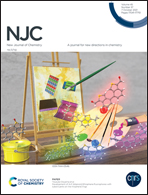Self-assembly of a benzothiazolone conjugate into panchromatic fluorescent fibres and their application in cellular imaging†
Abstract
We report the synthesis and characterization of the structures formed by self-assembly of 4-chloro-2(3H)-benzothiazolone (CBT) into panchromatic fibres and their application in cellular imaging. The aggregation properties of the synthesized compound were studied extensively under different solvents and concentrations and their morphologies examined at a supramolecular level by various microscopic techniques such as atomic force microscopy (AFM), fluorescence microscopy, and optical microscopy. Interestingly, the self-assembled structures formed by CBT reveal panchromatic emission properties and show blue, green, and red fluorescence under different excitation wavelengths. The mechanism of structure formation of the self-assemblies was studied through different techniques such as concentration-dependent 1H-NMR, ATR-FTIR, UV-visible spectroscopy, and fluorescence spectroscopy. Finally, the utility of CBT for cell imaging applications was demonstrated and it can be noted that CBT was efficiently taken up by mammalian cells and the cells revealed panchromatic emission in the blue, green, and red channels. The intensities of the fluorescence observed were blue > green > red and the dye interestingly does not exhibit any fluorescence quenching.



 Please wait while we load your content...
Please wait while we load your content...